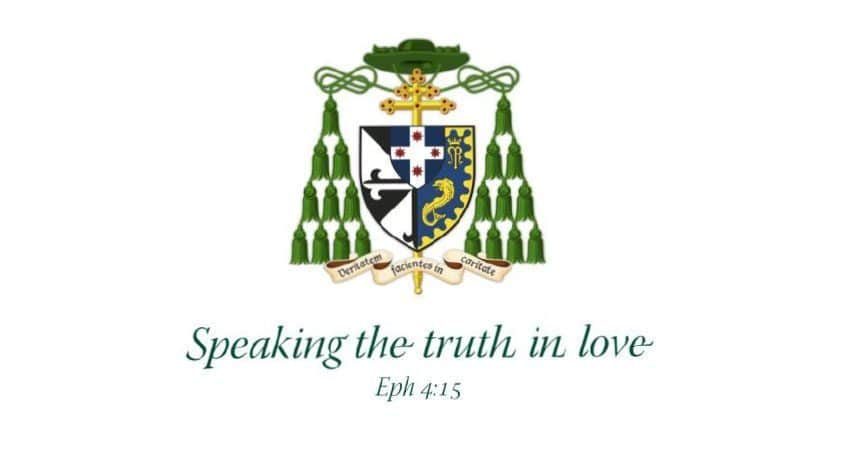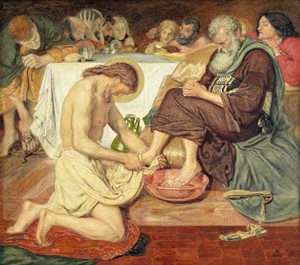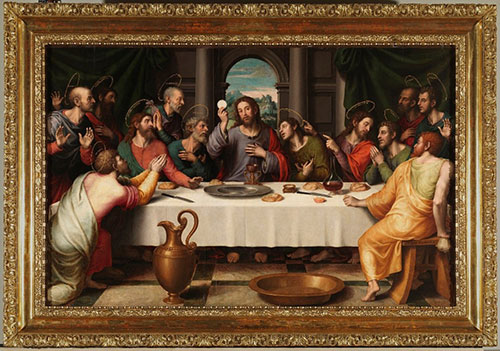I. DEATH’S DARK SHADOW: HOMILY FOR THE MASS OF THE LORD’S SUPPER

ST MARY’S CATHEDRAL, SYDNEY, MAUNDY THURSDAY, 6 APRIL 2023
It’s the most natural fear of all. Consciously or not, we do all we can to postpone it and to avoid thinking about it. We stave it off with medicine, hygiene, diet and exercise. But in the end death is inevitable: death and taxes, as they say. St Augustine called it “the debt that must be paid”.[1]
When it comes to death, modernity is into tax evasion. Our culture is in denial about ageing, frailty and death. Instead of practising the ars bene moriendi, the art of dying well, our materialist culture is panicked by death or rails against it like a petulant child, demanding a quick fix from healthcare, technology, money or government. [2] When ageing and dying can no longer be denied, we warehouse the unfortunates out-of-sight, out-of-mind. Children grow up accompanying the dying or seeing the dead. We even try to tame ageing and death, so they happen on our terms, through cosmetic and medical excesses, cryopreservation, stolen organs for transplant or, from later this year, “voluntary assisted dying”.
Try as we might to avoid thinking about it, death crashes through when it takes our loved ones. Last year I lost my dear mother, then my godfather, then my father, then most unexpectedly, my esteemed predecessor Cardinal Pell died. That’s a lot of deaths in just twelve months!
Others have it worse: think of the devastation in Ukraine from the Russian invasion, or in Turkey and Syria from earthquakes. Or of the Abdullah family losing three children to a drunk driver. King or peasant, archbishop or layperson, none is immune. Death’s dark shadow looms over us all.
Death is real and inevitable but not all negative.[3] Mortality frames our life and offers commentary upon it, so that many human values and the projects—such as family life, artistic creativity and social action—that share in and extend those values are only intelligible because we are beings with only a certain span of life. Death’s approach provides opportunity for conversion, reconciliation and service. The prospect of death challenges us: am I living a noble life, worthy of the years I have left?
Still we dread it, for in death we lose everything, including life itself. It can be bewildering, paralysing, depressing. But if we won’t be around anymore once we’re dead, why do we fear it so? Maybe it’s really dying we fear rather than death, the suffering and humiliation, loss of control, abandonment and burden. Maybe we’re afraid the full stop will come before we’ve finished the sentence. Perhaps the biggest reason death is so confronting is that we have so little experience of it. As Hamlet said, it’s the “undiscovered country from whose bourne no traveller returns.”[4] When entering the great unknown, trepidation is to be expected.
But there’s a deeper reason. Though death is natural for any living thing, there’s something deeply unnatural about it also. It goes against all our instincts. Put simply: we know in our bones we aren’t meant to die.[5] Our faith confirms this. The Book of Genesis says that God made man “a living being”, a being made for life, and that every living being is good (Gen ch. 1; 2:7). The Catechism teaches that “even though man’s nature is mortal, God had destined him not to die. Death was therefore contrary to the plans of the Creator and entered the world as a consequence of sin.”[6] To be alive is to share in God’s being, goodness, life and purpose; to be dead is being deprived of all that. The Book of Wisdom confirms this: “God did not make death, and he does not delight in the death of the living. He created everything so that it might continue to exist and everything he created is wholesome and good.” (Wis 1:13-14; cf. 1Cor 15:21; Rom 6:21,23)
As the story of human origins unfolds in the Bible, we learn that death was not a punishment so much as a logical consequence of sin. Human intimacy with God and so with immortality was damaged and we joined the other creatures in the valley of the shadow of death: “You are dust,” God reminds Adam, “and to dust you shall return” (Gen 2:17; 3:19).

Christ, of course, knew all this. He taught that God cares about our lives, so we shouldn’t worry too much (Mt 6:25-27). Yet even He wept at the death of His friend Lazarus and was indignant at the damage sin and death had wrought (Jn 11:33,35). Jesus is “the Way, the Truth, and the Life” (Jn 14:6), and so Confusion, Falsehood and Death are His opposites. He is “the Resurrection and the Life” (Jn 11:17), contrasting with Annihilation and Mortality. He came, He said, that we might have “life to the full”, life eternal.[7] And as a sign that He meant it, He raised Lazarus from the dead.[8]
On this night of blood, sweat and tears, Jesus kneels and washes His friends’ feet, to exemplify service, subvert worldly hierarchies, emphasise self-sacrifice (Jn 13:1-16). Since the time of Moses, ritual washing preceded the offering of sacrifices (Ex 30:17-21 etc.) Jesus wanted them to understand that their lives would be sacrificial too. “Greater love has no one than this, that he lay down his life for his friend.” (Jn 15:13)

Next, He takes bread and wine and utters portentous words: “This is my Body. This is my Blood” (Mt 26:26-29; 1Cor 11:23-26). “Unless you eat the flesh of the Son of man and drink his blood, you cannot have life in you. He who eats my flesh and drinks my blood has eternal life and I will raise him up on the last day.” (Jn 6:53-54) Jesus foretells tomorrow’s terrible events, when His Body will be broken like the host and His blood spilt like wine, His sacrifice perpetuated for us in the Eucharist.
Washing preceded sacrifice but also burial, as Jesus pointed out when a woman washed and anointed Him (Mt 26:6-13; Lk 7:36-38). After this Mass we will go in procession with Jesus and His disciples into the terrors of the night. Jesus is anxious, His men are too. He knows His own betrayal and execution are imminent. He prays that this chalice of wrath might pass Him by. But His Father’s will must be done, and God so loved the world He gave His only Son (Mt 26:39; Jn 3:16).
His disciples were washed, baptised into His death, so they might be ready to offer themselves also. Physical death would come in due course, but first a death to self. They must let go of power, security, comfort. As the Son of Man came to serve, not to be served (Mt 20:28), their mandate—tonight’s mandatum—is to do likewise (Jn 13:15). They must be ready for His sacrifice and theirs, His burial and ours also.
Death is real. Every living being recoils from it. It can seem like annihilation. It was not God’s plan for us. Yet it helps frame our lives, is the context for much good we do. And Christ has gone before us, so we need not fear it so much. Death is a door, and Jesus has left us the Eucharist as Viaticum, food for the journey into the beyond. If we die with Him, dare we hope we might rise with Him also? (Rom ch. 6; 1Cor ch 15). For the answer to that we must return tomorrow for the Liturgy of the Passion… See you then.
[1] Augustine, Tractates on the Gospel of John, XLIII.
[2] Christoph Schönborn, From Death to Life: The Christian Journey (Ignatius, 1995), ch. 6.
[3] A most enlightening treatment of these matters is Hayden Ramsay “Death Part I: What is death?” New Blackfriars 86(1001) (Jan 2005), 94-100, “Death Part II: The significance of our deaths,” New Blackfriars 86(1003) (May 2005), 302-307, and “Death Part III: Our attitude towards death,” New Blackfriars 86(1004) (July 2005), 418-424.
[4] William Shakespeare, Hamlet (ca 1600), Act III, Scene I, lines 80-81.
[5] See Joseph Ratzinger, Commentary on the Documents of Vatican II, vol 5, ed. H Vorgrimler (New York: Herder and Herder, 1969), 140.
[6] CCC 1008, citing Wis 2:23-24. Likewise, CCC 1006, citing Rom 6:23 and Gen 2:17.
[7] Mt 7:14; 10:39; 16:25; 19:16-30; 25:46; Lk 10:25; 18:30; Jn 1:4; 3:15-16,36; 4:14; 5:24-40; 6:33-68; 10:10,28; 12:50; 17:2-3.
[8] Mt 9:18-19,23-26; Lk 7:11-17; Jn 5:21; 11:1-44.
INTRODUCTION TO THE MASS OF THE LORD’S SUPPER
ST MARY’S CATHEDRAL, SYDNEY, MAUNDY THURSDAY, 6 APRIL 2023
Welcome to St Mary’s Cathedral in Sydney for the Mass of the Lord’s Supper, beginning the three-day-long Sacred Triduum commemorating the Passion, Death and Resurrection of the Lord. On the night before He died, Christ gave us a lasting example of Christian service, through the washing of His disciples’ feet and concluding Mandatum; He gave us ministers of His word and sacraments, through establishing the Sacred Priesthood; and He gave us a perpetual memorial of His all-sufficing sacrifice in the institution of the Holy Eucharist. Tonight we recall with gratitude the night on which He gave us three such momentous endowments.
I acknowledge concelebrating with me Bishop Terry Brady, Dean Don Richardson and the Cathedral clergy, the Seminary Rector Fr Michael de Stoop and seminary faculty, assisting deacons, and seminarians of our archdiocese. As we witness Christ’s Last Supper and proceed with Him out into the darkness tonight, and as we join Him on His way to the cross and tomb tomorrow, we ask Him to raise us out of the graves of our sins and anxieties to new life with Him at Easter…

